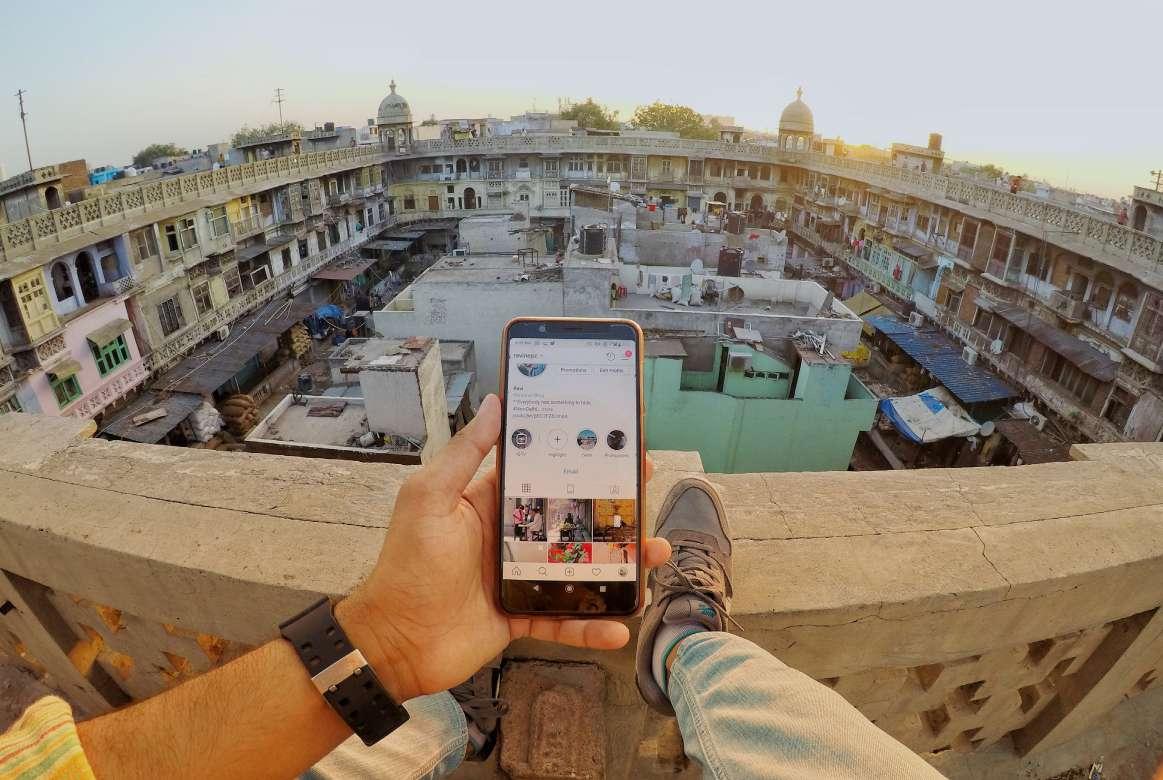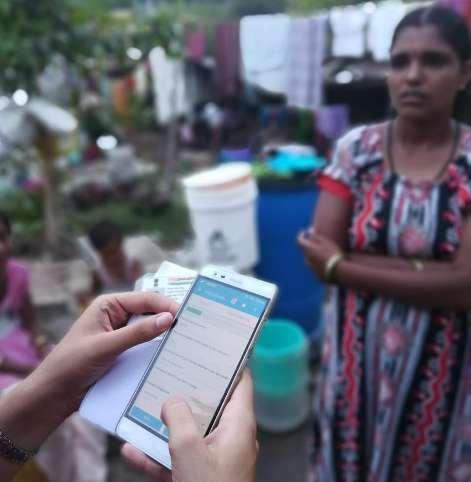CATALYZING CIVIC TECH IN INDIA

1
with Knowledge PartnerAn Insight Report from and
Authors:
Ben Wrobel, Director of Communications, Village Capital
Snehil Basoya, Senior Manager - Insights, CIIE.CO
Deepak Menon, Senior Director, Emerging Markets, Village Capital
Contributors:
Supriya Sharma, Partner - Insights, CIIE.CO
Vipul Patel, Partner - Seed Investing, CIIE.CO
Shreyansh Chandak, Associate, South Asia Programs, Village Capital
Rustin Finkler, Communications and Research Manager, Village Capital
Perry Nunes, Village Capital

Supported by:
Bharath Visweswariah, Director, Investments, Omidyar Network India
Apoorva Goyal, Associate, Investments, Omidyar Network India
Tariq Musthafa, Associate, Investments, Omidyar Network India
Aakarshi Agarwal, Consultant, Investments, Omidyar Network India
1
ABOUT THE ORGANIZATIONS
CIIE.CO is The Innovation Continuum. This continuum spreads from incubation, acceleration, seed and growth funding and research. Founded at IIM Ahmedabad in 2002, as an academic center, CIIE.CO has grown and pivoted from to include acceleration, incubation, investment, research and publication. Overall, we have aimed at filling the multiple, ever-evolving gaps in the Indian innovation-driven entrepreneurship space in many ways. Among various initiatives, CIIE. CO has conceptualised and hosted India’s first accelerator, created India’s first and so far the only cleantech-focused fund, accelerated over 600 entrepreneurs, funded over 120 startups, inspired over 700,000 with our publication - Stay Hungry Stay Foolish.

All the initiatives on the innovation continuum are aimed at supporting the fearless, innovationdriven entrepreneurs. Working with like-minded partners like corporates, government agencies, investors and academia, helps us push harder towards co-creating exponential change.
Village Capital helps entrepreneurs bring big ideas from vision to scale. Since 2009, they have supported more than 1,000 early-stage entrepreneurs through our investment readiness programs. Their affiliated fund, VilCap Investments, has provided seed funding to more than 100 program graduates.
Last year Village Capital partnered with Omidyar Network India on a first-of-its-kind accelerator program to train and catalyze investment and partnerships for early-stage civic tech ventures in India. More than 100 civic tech startups applied and 14 participated, and the workshops were a key convening point that brought together more than 70 entrepreneurs, influencers, government leaders, and potential funders.
PARTNER
Omidyar Network India invests in bold entrepreneurs who help create a meaningful life for every Indian, especially the hundreds of millions of Indians in low-income and lower-middleincome populations, ranging from the poorest among us to the existing middle class. To drive empowerment and social impact at scale, it works with entrepreneurs in the private, nonprofit and public sectors, who are tackling India’s hardest and most chronic problems. The organisation makes equity investments in early stage enterprises and provides grants to nonprofits in the areas of Digital Identity, Education, Emerging Tech, Financial Inclusion, Governance & Citizen Engagement, and Property Rights. Omidyar Network India is part of The Omidyar Group, a diverse collection of companies, organizations and initiatives, supported by philanthropists Pam and Pierre Omidyar, founder of eBay
2
KNOWLEDGE
INTRODUCTION
It’s not often that you witness the creation of a sector, but that’s exactly what we have seen in the United States in the past decade. Starting with the naming of the first-ever Chief Technology Officer in the history of the United States in 2009, and continuing through efforts by philanthropy, government and the private sector, the civic tech sector in the US has grown from virtually non-existent to a billion-dollar industry.
What will it take for civic tech to get there in India? The civic challenges are certainly paramount, and there are entrepreneurs trying new things - an estimated 450-475 civic tech startups in India today. But much of the support for these innovators has still been philanthropic. The sector won’t become self-sustaining — as it has in the US — until venture investors understand that civic tech startups have scalable, sustainable business models, and provide the capital that the sector needs.
In this report we’ll seek to help venture investors understand civic tech in India. We’ll define civic tech, and identify emerging subsectors and promising revenue models. Finally, we’ll explore appropriate funding strategies for investors to consider, since equity is not always the best option for startups solving complex civic problems.
It’ll take more than investors, of course. We’ll also offer clear, actionable takeaways for government, philanthropy and entrepreneurs themselves to build out the sector. Civic tech finally has a chance to take off in India - but it will take a deep coordinated effort across sectors — entrepreneurs, investors, philanthropy and government.
Last year an Omidyar Network India and Village Capital survey of 287 Indian citizens found that:
80%
believe that civic tech solutions can help facilitate a direct communication line with their government authorities
Supriya Sharma, Partner - Insights, CIIE.CO
MORE THAN 50%
believe that civic tech will help strengthen citizen trust in government and its services
74%
expect civic tech to help engagement and participation with government and civic bodies
3
What does it take to define a new sector in the economy?
Deepak Menon, Senior Director, Emerging Markets, Village Capital
THE MOMENT
Several issues across India — the deteriorating air quality in Delhi, the crumbling infrastructure in Mumbai, the many gaps in service delivery among local governments — all point to significant challenges in governance across the country. At the same time, citizens’ aspirations are growing dramatically and expectations for quality of life look completely different than they did even a few years back.
Unfortunately, governments haven’t been able to keep up with this evolution due to underlying issues such as inadequate staffing, opaque processes with little to no citizen inputs, and poor public service delivery infrastructure, and the country is seeing large gaps between the interests of citizens and relevant public action.
Civic tech has emerged globally as a promising approach to address such issues, born from optimism about the potential of technology and data to improve governance, empower citizens, and drive social impact.
We believe that the civic tech market in India is poised to grow. Entrepreneurs are beginning to engage on tough civic problems with the backing of committed government partners. Several factors are enabling the emergence of this ecosystem:
• Smartphone adoption: More than 175 million smartphone users are expected to come online over the next five years, as the cost of cellular data plummets.
• Tech talent: India is the world’s third largest startup hub, with 39,000 active startups, and “deep tech and advanced tech” startups growing at 50%. The ITBPM industry alone grew 9.2% in 2018-19.
• Government incentives: India’s government has focused on incentives to improve digital access (Digital India) and modernize cities through technology (Smart Cities Mission).
The time is ripe to bring about a quantum change in the quality of governance through the use of civic tech. The use of civic tech can dramatically improve the delivery of services to citizens and refine the Indian government’s responsiveness to important civic issues.
Adapted from an article by Bharath Visweswariah1
4
ABOUT THIS REPORT
This report will aim to help catalyze the civic tech sector in India. Specifically, we will:
• Provide a definition of civic tech in India by identifying emerging subsectors.
• Explore promising revenue models for startups in each subsector.
• Conclude with clear, actionable takeaways for investors, government leaders, philanthropic leaders and civic tech entrepreneurs.
The report is based on the experience of Village Capital and CIIE.CO working in the civic tech space in India.
Village Capital first engaged with the civic tech sector through Civic Tech: India 2018, an accelerator program run by Village Capital and Omidyar Network India that was aimed at improving the investment-readiness of 22 startups. The accelerator featured more than 80 mentors including government leaders (Smart Cities Mission, Delhi Jal Board), venture capital firms and corporate partners.
Additional insights were gained from a “Startup Roadshow” that Village Capital led in the cities of Kanpur and Ahmedabad, to find innovation happening outside of major Indian cities.
On a mission to back game-changing entrepreneurs, CIIE.CO has filled gaps in promising sectors characterized by market failures and little institutional support. Civic tech has been one such sector where CIIE.
CO has undertaken several interventions including accelerators, seed investments and in-depth research. In 2018, aiming to weave together a somewhat fragmented space and outline the market opportunity, CIIE. CO undertook an investigation of civic tech in India. Insights from this analysis and the experience of working with civic tech startups were distilled for this report.
5
TAKEAWAYS
INVESTORS
» Consider alternative models for investment, beyond equity.
» Enable startups to work with the government.
GOVERNMENT
» Ease restrictions on eligibility requirements for government tenders.
» Train government workers in digital literacy.
PHILANTHROPY/NGO’S
» Support organizations with hybrid business models.
» Consider capacity-build and multi-year funding models.
» Consider making program-related investments.
CIVIC TECH ENTREPRENEURS
» Government agencies can play a key role in helping your business achieve scale.
» Consider opportunities to create revenue models beyond government.
» Consider hybrid revenue models that include philanthropic funding.
6
TOWARDS A UNIFIED DEFINITION OF CIVIC TECH
What is Civic Tech? There will never be a perfect definition. It has been defined by several practitioners across the globe, each of them conveying a slightly different meaning than the other.
Some existing definitions:
• Technology that enables greater participation in government or otherwise assists government in delivering citizen services and strengthening ties with the public. - GovTech.com
• Technology that is used to empower citizens or help make government more accessible, efficient, and effective. - Omidyar Network
• Technology that informs and encourages civic engagement, from simplifying voter registration to hosting virtual government town halls to launching crowdfunding campaigns supporting civic assets. - Knight Foundation
Our full definition is:
Technologies that empower citizens to engage and participate in governance and better access government services as well as those that enable governments to become more accessible, efficient and effective in delivering services to citizens.
7
We studied these definitions and concluded that, in India, the sector should be viewed as an amalgamation of two complementing verticals — streamlining government services and improving civic engagement.
Streamlining government services:
One stream of civic tech companies in India are those that augment and streamline the work of local and national government by providing front-end technology and back-end infrastructure, specifically:
Front-end technology that increases the quality, efficiency, and accessibility of services provided to the public, around such areas as transportation, water and sanitation, and waste management
Back-end technology infrastructure, software tools and hardware that help government collect, organize and make decisions based on data in order to engage more proactively with citizens and deliver civic services more effectively, accessibly and transparently. Often known as “govtech”
Improving civic engagement:
The other stream of civic tech companies in India are those that empower Indian citizens by driving their participation in public decision-making processes and governance through:
Government-to-citizen communication allowing them to engage with government more easily and proactively
Citizen-to-citizen communication allowing them to engage with each other and organize themselves around civic issues more easily
In the coming pages we will explore each subsector in more detail, and frame common opportunities, challenges and revenue streams for startups in each one.
8
1 2
SUBSECTORS
In the following pages we’ll look at some emerging sub-sectors, and the revenue models that are working for each one.
9
CIVIC TECH STARTUPS
SUBSECTOR DEFINITION
Front-End: Transportation, Water & Sanitation, Waste Management
Streamlining Government Services
Backend Government Management Tools
Startups that provide front-end technology that increases the quality, efficiency, and accessibility of civic services provided to the broader public.
COMMON REVENUE MODELS
Improving Civic Engagement
Governmentto-Citizen Communication
Startups that provide backend tech infrastructure that improves government operations, particularly better ways of collecting, organizing and making decisions based on data.
Startups that facilitate direct engagement between governments and citizens in one or both directions, from direct-to-citizen service delivery to feedback and communication platforms.
Citizen-to-Citizen Engagement and Communication Startups that connect citizens with each other in order to discuss, organize, and/or fund civic projects through community-based platforms
10
SaaS SaaS SaaS Consulting Consulting Consulting Commission Fee Commission Fee Syndicated Data Syndicated Data Syndicated Data Adverstising Adverstising Product Sales Product Sales
REVENUE MODELS
Investors new to the civic tech space may be skeptical whether these startups have sustainable sources of revenue. We have identified several revenue models that are common in the civic tech space:
Software as a service (SaaS)
SaaS
SaaS is a very common model for tech startups around the world, and, unsurprisingly, it is the most common revenue model across Indian civic tech startups.
Many civic tech startups in India employ a SaaS model to offer proprietary software solutions to government bodies at both the local/state (urban local bodies) and national (ministries, national boards, etc) levels. These range from generic to customized offerings, and often come with one-time hardware and installation fees along with recurring subscription costs. Startups also use this model to sell to non-government clients like corporates and private institutions.
Applies to:
Consulting
Many civic tech startups begin as consulting engagements and short-term implementation projects for a government agency or development agency (there is significant funding from multilateral organizations like the Asian Development Bank, the World Bank and the Bill & Melinda Gates Foundation for projects that are linked to civic outcomes).
It is common to see a startup partner with a larger technology consulting firm or system integrator (i.e. PwC, Deloitte, Dalberg) to win a large government or development sector project, and then spin off to become an independent consultant. For civic tech startups in India, aligning with larger system integrators is often the most likely way to begin getting visibility and credibility for government contracts.
11
Consulting
Product Sales
Product Sales
Firms have a hardware product that governments buy, ranging from modular toilets to waste management technology to other public infrastructure. These products increase the quality, efficiency, and accessibility of civic services provided to the broader public. Since efficient delivery of services is a major government priority at all levels, product startups are in great demand.
Applies to:
Commission or Fee Syndicated Data
Commission or Transaction Fees
Commission fees are common for startups that enable more efficient or transparent transactions. This is especially common for platforms that enable monetary transactions (i.e. civic crowdfunding) or non-monetary exchanges (i.e. streamlining application processes for government services).
Applies to:
Advertising
Syndicated Data
Citizen-facing portals have significant aggregated citizen data on everything from voting behaviour to consumption information. This data is an attractive revenue option for startups, which can sell it to public utilities and government bodies for better decisionmaking on their end.
Applies to:
Advertising
Citizen-facing platforms with an engaged user base offer exciting revenue opportunities for any stream of advertisements. This could, however, sometimes cause concerns about industry or political affiliation of the platform.
Applies to:
12
WASTE MANAGEMENT
THE PROBLEM
Waste management is a hot issue in urban management in India. Indians generate 62 million tons of municipal solid waste each year, but only 43 million tons are collected, and under one million tons are treated. The rest ends up in landfills.2
Waste management is complex: there are several different stakeholders to coordinate, from the households and businesses that generate waste, to the ragpickers, kabadiwalas and traders that handle it, to the recycling centers and landfills that receive it. The lack of uniformity in different cities has made it difficult to consistently replicate international models of waste planning.

13
STREAMLINING GOV’T
SERVICES
WHERE TECH STARTUPS CAN CONTRIBUTE:
There have been recent government pushes to improve waste management, through the Smart City initiatives, the Swachh Bharat Mission, and legislation that requires corporations to recover waste material and reuse it for production.3 But top-down schemes have proved to be of limited value, and startups can be more nimble and benefit from on-the-ground expertise. All stages of the waste value chain, namely generation, segregation, collection, recycling, dumping and processing, require technological interventions. There are opportunities for startups to generate revenue at different stages, from on-site segregation and management to streamlined collection and improved processing.
There are significant challenges. The country’s lack of uniformity presents a challenge to scale: every city’s solution is so unique that a tool that works in one city may not be effective in another. There is a lack of reliable data on how waste has been generated, collected, recycled and processed. Municipal authorities are responsible, by law, for segregating and processing waste, but many fail to do so, and fewer track good data. This makes it difficult to create predictive models, or to effectively measure outcomes. Finally, waste mafias are sometimes prevalent in large cities and can control prices for recycling.
RECENT DEALS
Nepra - a waste management company that operates under the ‘Let’s Recycle’ brand

from Asha Impact and Aavishkaar (2018).4
Saahas Zero Waste - which provides end-to-end waste management solutions


Karma Recycling - an e-waste recycling and refurbishing startup
including $870k from C4D Partners, Asha Impact, and Artha India Ventures (2019).6
from Infuse Ventures and The Low Carbon Enterprise Fund (2015).5
14
Raised $6.5M Series B round Raised $460k Has raised $1M cumulatively WASTE MANAGEMENT
REVENUE STREAMS

CUSTOMERS
• Public sector: Waste management companies frequently win tenders and short-term projects from governments (especially Urban Local Bodies). They can generate revenue from governments at different stages of the waste value chain.
• Private sector: There is wide demand for technology tools, data intelligence and efficient segregation processes from recycling companies, purchasers of recycled plastic (notably automotive and fast-moving consumer goods), and waste-to-energy companies. Demand is boosted by Extended Producer Responsibility (EPR) laws, which require corporations to recover waste material and reuse it for production.
STARTUPS TO WATCH
Banyan Nation is a technology-driven waste management and plastics recycling company that also sells a data intelligence platform that helps cities track their waste.

Waste Ventures offers Hyderabad’s first digital professional waste collection service to households, corporates and waste pickers.

ReCity helps governments and corporates to create and implement solutions in waste management, sanitation, and EPR through participatory urban planning.
Citizengage connects waste collectors to people in Bengaluru who want a responsible waste management system, which ensures that the collected waste is being recycled and put to good use.

15
SaaS Consulting
WASTE MANAGEMENT
On-Field OperartionsProduct Sales
CASE STUDY: Saahas Zero Waste
Every year India generates 63 million tons of waste. The country’s landfills are designed to hold 10% of that waste product, but in practice they end up holding more than 90%. Saahas Zero Waste is a social enterprise that provides end-to-end waste management services for Indian towns and cities, based on the principles of the “circular economy”.
Saahas was founded in 2001 as an NGO to help Indian businesses understand and implement waste management rules. Over time Saahas’ founder, Wilma Rodrigues, realized that the organization’s status as an NGO, and their reliance on grants and adhoc CSR budgets, was holding them back from truly systemic impact. In 2013 Saahas transitioned to a for-profit model.
In its initial years as a business, Saahas struggled with customer acquisition. Rodrigues and her team struggled to make customers understand that waste management is about more than just disposal; in fact, up to 90% of the waste generated can be recovered, but it requires complicated logistics around transportation, storage and aggregation.
Over time, however, the Saahas team was able to educate and ultimately grow its customer base. Saahas is now diverting more than 13,000 tonnes of waste from landfills every year, and is employing more than 250 people, with 85% of female employees coming from lower socio-economic groups in the country.

There are still challenges. Saahaas drives most of its revenues from the sale of waste and service fees. They have sometimes struggled to navigate eligibility requirements for government tenders. They have struggled to find partner organizations working in resource recovery. Perhaps their most important challenge is the poor enforcement of regulations that allows bulk waste generators like corporations to avoid dealing with their waste entirely.
Still, the company has made steady progress. Saahas recently worked with the Karnataka government to create policy and strategy around waste management, and is now setting up a micro-entrepreneurial venture on solid waste management in Africa through UK Aid funded initiatives. In 2018 its flagship Zero Waste Program for bulk waste generators won the prestigious Swachh Bharat Mission Best Practice Award.7 By 2020, Saahas aims to be handling more than 100 tons of waste in India every day.
16
WASTE MANAGEMENT
WATER & SANITATION

THE PROBLEM
Nearly 70% of Indians get their drinking water from the public tap, but the quality and availability of that water are often seriously limited.8 City administrators overseeing the water supply have minimal access to realtime, hyperlocal data, leading them to make high-stakes decisions based on incomplete information.
Water utility providers in particular struggle with high operational costs and inefficient delivery of services to their end customers. Meanwhile, sanitation remains a challenge in rural areas: only 34% of rural Indians have access to sanitation centers. The spread of water-borne diseases represents a serious public health risk.9
17
STREAMLINING GOV’T SERVICES
WHERE TECH STARTUPS CAN CONTRIBUTE:
Smaller companies are well positioned to help capture and utilize data around water and sanitation, and build upgrades to existing infrastructure. Entrepreneurs are exploring both SaaS and Internet of things (IoT) solutions to issues like quality of water distribution, reservoir efficiency, minimising leaks, water consumption, water metering and revenue collections, wastewater infrastructure, and village and crop mapping for irrigation, to name a few. There is also a big potential opportunity in disaster management, creating preventive measures for droughts and floods.
Startups working with government clients can face working capital issues because of a lack of upfront payments. Given that several solutions are hardwarebased with high capital expenditure, this can be an area of concern for some entrepreneurs.
RECENT DEALS
Drinkwell - which blends nanotechnology with turnkey water solutions to deliver clean drinking water to the public


NextDrop - which tracks water shortages and informs Indian citizens via text

from ADAP, 1to4 and TPG Rise Fund (March 2018).10
Swajal - an IoT-enabled water purification solutions provider

from Y Combinator (2017).13
from Saurya Enertech and TLabs (2015).12
SaraPlast - a manufacturer of sanitary facilities and provider of sanitation services and liquid waste management
from Aavishkaar and ResponsAbility (2013).11
18
Raised
Raised $2.26M Series A round Raised $1.2M Raised $120K WATER & SANITATION
undisclosed amount
REVENUE STREAMS
CUSTOMERS
• Public sector: The sector has a diverse array of public clients in municipal corporations, water supply departments, sewage operation departments, etc. There is high interest in water and sanitation from international organizations and development finance institutions that can supplement public budgets.
• Private sector: There is again a variety of private customers for entrepreneurs to explore and serve (eg pipeline contractors, urban planners). Boosted by the government’s Smart Cities initiatives, several private players are expected to execute and implement efficient water management and delivery solutions in the coming years for the government. There is huge potential in creating partnerships.
STARTUPS TO WATCH
Faclon Labs provides an IoT-based hardware and software solution to better manage water infrastructure and operations.



Fluid Robotics works with urban local bodies and irrigation departments across India to help better manage their water resources and wastewater infrastructure.
Samagra SmarLOO is the newest technology product of sanitation organization Samagra, which focuses on improving existing public toilet infrastructure through sensors, an analytics dashboard, and user-centric design.
Ekam Eco Solutions builds user-centric and sustainable sanitation systems, including patented waterless urinal odor technology called “Zerodor”, as well as organic cleaning solutions and waste management systems.

19
SaaS Consulting
WATER & SANITATION
On-Field OperartionsProduct Sales
CASE STUDY: GARV Toilets
India still suffers from wide disparities in access to sanitation services: an estimated 23 million Indians do not have a toilet in their home.14
The Swachh Bharat Abhiyan (Clean India Mission) has seen moderate success, building millions of toilets across the country. Local governments have also invested in public toilets. But these toilets are frequently vandalized and have irregular maintenance, leading to low public perception by Indian citizens.

Mayank Midha built GARV toilets primarily to combat that last point. “In order to have meaningful behaviour change in public sanitation, there needs to be a change in public perception,” says Midha, founder and CEO of GARV. “Our hope is that by providing clean, durable toilets and other reliable services, we can begin to build trust.”
GARV builds tech-enabled “smart sanitation centres” for public use in lowincome urban communities. GARV has launched 720 of these centres across India, Bhutan, Ghana, and Nigeria, serving 250,000 users every day.
The cornerstone of each centre is a solarpowered, modular “smart toilet” unit made of stainless steel that is difficult to vandalize. Each toilet has sensors that feed data into a back-end dashboard for administrators to monitor user hygiene behaviour — as well as a sanitary napkin
vending machine and incinerator for women, and specially-designed toilets for users with disabilities.
Many smart sanitation centres also include a bath facility, sanitation kiosk, laundrette, and clean drinking water access. GARV eventually plans to build these centres into community hubs, offering services like health check-ups and micro-insurance sign-ups.
GARV has been experimenting with alternative revenue streams beyond direct toilet sales and public-private partnerships. In several communities they earn revenue from pay-as-you-go sanitation services and advertising revenue. They have also tapped into funding from foundations and corporate foundations, including the Aga Khan Foundation, Coca Cola Foundation, and the State Bank of India. This grant funding has helped the company mitigate the risk of relying only on long government sales cycles — and bodes well for diversified revenue options in GARV’s next phase of growth.
20
WATER & SANITATION
MOBILITY & TRANSPORTATION
THE PROBLEM
Traffic and transportation in India are more than a pain for commuters and a catastrophe for the environment: a recent study found that traffic congestion during rush hour in Delhi, Mumbai, Bengaluru and Kolkata cost the economy a total of $21 billion each year.15
As Indian cities grow, often at breakneck speeds, mobility is becoming a critical challenge. With more vehicles on the road, traffic increases, air quality deteriorates, and road quality becomes more difficult to monitor and maintain. Public transportation systems are turning into complex, costly operations that struggle to support the needs of increasingly mobile citizens.

21 STREAMLINING GOV’T SERVICES
WHERE TECH STARTUPS CAN CONTRIBUTE:
As government agencies and big companies struggle to navigate these challenges, there is an opportunity for startups to step in with tools for infrastructure monitoring, transport planning, ridesharing and more. These smaller companies are more flexible, and well positioned to partner with municipalities and transit authorities to scale their solutions.
Challenges include regulatory roadblocks: urban transportation regimes often tend to have a complex set of licensing and zoning rules.
RECENT DEALS
Bounce - an electric scooter sharing company


Ridlr - an end-to-end public transport ticketing and commuting app
from B Capital, Falcon Edge Capital, Omidyar Network India and others (2019).16
by Ola in an all-stock transaction (2018).18
GetMyParking - a mobile application that allows users to search and navigate to the nearest parking lot
from Indian Angel Network, BEENext and IAN Fund (2017).17

22
Raised $72M Series C round Raised $3M Series A round Acquired at over $25M MOBILITY & TRANSPORTATION
REVENUE STREAMS

CUSTOMERS
• Government as a client: Urban local bodies, transit authorities and transportation hubs across the country require civic tech startups to step in for infrastructure monitoring, traffic planning and management, effective public transport solutions, efficient passenger interface, future mobility blueprints and implementation, etc.
• Citizens and businesses as clients: Parking solutions for busy public/private spaces, last-mile transport solutions for public transport, ridesharing platforms, bicycle and e-bike usage services.
STARTUPS TO WATCH
RoadBounce uses mobile-based road condition assessment technology to capture the condition of roads and provide a list of high-priority patches to be fixed.

Mobycy enables short-distance commuters to rent bicycles and scooters via an app on their smartphones.
Journee provides a platform that enables transport agencies to make data-driven planning decisions, and empowers commuters to buy tickets and plan routes using a mobile app.

ValetEZ is focused on solving congestion in cities through smart parking solutions based on mobile, cloud and IoT.

23
MOBILITY & TRANSPORTATION
SaaS Consulting Platform-asa-ServiceProduct Sales
CASE STUDY: ValetEZ
With more than 230 million vehicles on the road in India, traffic and congestion are a daily issue. In recent years, parking has also become a hot button topic. Many cities have a limited number of parking spaces, and tempers can flare as commuters compete for a small number of spots.

ValetEZ is a “smart parking” firm that is leveraging technology to bring order to the daily chaos of public parking. Founded by former strategy consultant Prashant Chandrasekaran and serial tech entrepreneur Smit Kant Raturi, the company offers a cloud-based, digitized system that helps parking lot operators manage their supply of spaces.
In its early days ValetEZ was focused on parking lots owned by private operators, like airports, malls and hospitals. They have helped dozens of these institutions digitize parking in their lots, and they are currently operational in seven cities, including Bangalore, Delhi, Hyderabad and Chennai.
Recently the company has started exploring projects with government authorities to address the crisis around on-street parking management. Part of the reason that government has been slow to address the problem is that many parking operations companies are expensive and low-tech, offering bulky hardware-software combinations that come with heavy labor costs.
Chandrasekaran and Raturi believe that the company’s experience makes them well-positioned and a reliable partner for government in improving the lives of commuters.
ValetEZ has evolved from an operationsheavy revenue model to one where the bulk of revenue now comes from system licenses. They are exploring ways to tap into automation and dynamic pricing to help them scale. Chandrasekaran and Raturi see a future where a large user base allows them to tap into economies of scale and gain valuable data. Their vision is to bring together three stakeholders - parking lot operators, commuters and government - to reimagine on-street parking in India.
24
MOBILITY & TRANSPORTATION
STREAMLINING GOV’T SERVICES
BACK-END GOVERNMENT MANAGEMENT TOOLS
THE PROBLEM
Effective governance is a complicated technical beast. Many government bodies in India still run on manual, paper-based processes. This legacy infrastructure results in a lack of reliable and easily accessible data, which can make communication and decision-making more time-consuming and less effective.
This is starting to change. Open data initiatives like the National Data Sharing and Accessibility Policy and the Right to Information Act are making public data more available than ever, and players like the eGovernments Foundation are leading a movement towards open sourcing and data sharing. New technologies, especially around artificial intelligence, machine learning and data visualization, have the potential to make government operations more effective and data-driven.

25
WHERE TECH STARTUPS CAN CONTRIBUTE:
The effort to modernize legacy systems is often led by large IT consulting firms and system integrators which bid for government contracts. There is, however, an opportunity for smaller niche companies to provide complementary solutions to these established service providers in their areas of technological or domain expertise. Outside of large IT consulting firms, which often build out solutions themselves, the major players have a variety of approaches (e.g. ICT systems for Dimagi), sector focuses (e.g. infrastructure management for Transerve) and software tools (e.g. Salesforce for Vera Solutions).
There are inherent challenges that startups and vendors face when dealing with any government authority as clients, and these are felt particularly strongly when working directly with government employees, who may have low digital literacy. Requirements frequently change and request-for-proposals are sometimes unclear or vague, and for products that require significant changes to a government’s digital infrastructure, changes in municipal leadership can lead to cyclical loss of buy-in.
RECENT DEALS
Gaia - an IoT startup building solutions for smart cities

from various angels (2018).21
Transerve Technologies - which sells geospatial technologies to governments, corporations and builders


Dimagi - which delivers open and innovative technology to help underserved communities everywhere
from Omidyar Network India, IL&FS, CIIE.CO and CIBA (2017).20
from USAID and BIRD Foundation (2014).19
26
RECEIVED GRANT FUNDING Raised $1.67M Raised $1.5M Pre-Series A BACKEND GOVERNMENT MANAGEMENT TOOLS
REVENUE STREAMS

CUSTOMERS
• Governments as clients: With a huge push for digitising government processes and Smart City solutions, all government machinery across all levels requires enterprise solutions (SAP, BPR, etc.) for internal efficiency, digital products (websites, apps, etc.) and GIS solutions (mapping, surveying, software, use of open source data and technologies, etc.). In election years, startups can more effectively sell to government if they can link improved results to political capital.
• Businesses as clients: Companies can balance revenue streams between government and private sector customers, with the same product offerings and tiered pricing. Philanthropic money can be a supplementary source of income, specifically from the Asian Development Bank, the World Bank, the Bill & Melinda Gates Foundation and other multilateral organizations.

STARTUPS TO WATCH
Akara provides geovisual analytics platforms for enterprises and governments to make informed decisions via baseline studies and continuous real-time monitoring.

Chainframe builds blockchain platforms to manage public finances for government agencies, administrators and citizens.

EmpowerU develops intelligent solutions for real-time monitoring and evaluation for government schools.
How India Lives is an internet-based application that aims to organise a massive amount of public data on India and make it available in a searchable, comparable and visual format.
27
SaaS Consulting Syndicated DataProduct Sales
BACKEND GOVERNMENT MANAGEMENT TOOLS
CASE STUDY: eGovernments Foundation
eGovernments Foundation was one of the original organizations to help urban municipal government bodies move from pen-and-paper to more efficient digital systems.
The organization was founded by Nandan Nilekani and Srikanth Nadhamuni in 2003, when internet penetration in India was still at a very nascent stage. They had to fight early challenges like low digital literacy among government workers, and a lack of digital infrastructure. Still, they managed to grow to more than 200 urban local bodies (ULBs) in just their first few years, including the development of a full stack solution for the Chennai Municipal Corporation.
One of the biggest moments in their growth journey came in 2015 when the state of Andhra Pradesh made the decision to implement the software tools across all 110 ULBs in the state. The state has experienced dramatic efficiency and operational improvements since implementation. These days, it serves an additional 450 ULBs in Karnataka, and while it has made more headway in southern states, it has also done work in northern states like Punjab.

eGovernments Foundation builds technology for both government leaders and citizens. Local government agencies use their platform to improve their backend operations — including financial management, human resources management, tracking tenders for government contracts, and renting and
leasing property. Meanwhile, citizens use their platform to apply online for property taxes and utility taxes, file grievances, or track the status of applications and payments. Their mobile app has been downloaded more than 400,000 times.
In 2013, the foundation took a strategic leap by committing to become entirely open source. After an overhaul of their tech architecture, the new platform allows external developers to build digital solutions using its technology stack.
eGovernments Foundation has a hybrid business model. It raised $1 million from Omidyar Network India as a grant in 2016 and has raised over $5 million in funding since the beginning of 2017. CEO Viraj Tyagi recently told Fortune India that despite being a not-for-profit, the Foundation has been able to scale up and become sustainable because of strategic inputs from Omidyar Network India, which has utilised its experience of investing in and scaling up commercial ventures.
28
BACKEND GOVERNMENT MANAGEMENT TOOLS
IMPROVING CIVIC ENGAGEMENT
FACILITATING GOVERNMENT -CITIZEN COMMUNICATIONS
THE PROBLEM
Mobile technology has revolutionized the way that Indian citizens communicate with government. However, there is still much work to do in improving the quality and effectiveness of that communication. In 2014, India’s national government rolled out MyGov, an online tool to promote civic engagement by letting citizens share their opinions, feedback and ideas with government leaders. While it has been effective, it is only the beginning.

29
WHERE TECH STARTUPS CAN CONTRIBUTE:
Startups are building tools to help local government authorities communicate and engage with citizens, and ultimately provide public services that better meet actual needs. These include tools that build on the work of MyGov and the Smart Cities Mission to help citizens offer ideas and address grievances, as well as tools that improve delivery of government services, from welfare benefits to public information requests.
Customer acquisition in remote areas can be costly and require large on-theground teams. Customer engagement and retention can also be challenging, due to the need to sustain regular transactions and actually ensure improvement in government responsiveness. Finally, regulatory restrictions around third-party technology providers can be burdensome, especially for startups working around voting and elections.
RECENT DEALS
Haqdarshak - which runs a proprietary mobile/tablet-based application that has a complete database of relevant government and non-government programs available to the underserved

from various angels (2017).22

EasyGov - a SaaS startup that provides cloud services to improve efficiency, transparency and effectiveness of the delivery of government welfare programs
from various angels (2017).23
30
Raised UNDISCLOSED AMOUNT Raised $191K
FACILITATING GOVERNMENT-CITIZEN COMMUNICATIONS
REVENUE STREAMS
CUSTOMERS
• Governments as clients: Many state and city level government bodies are developing their own innovative technologies in-house — such as the state of Maharashtra’s mobile app for discovering relevant schemes — and while these can be competitive to some startups, they are complementary to others. Given the magnitude of hyperlocal issues concerning citizens, entrepreneurs can focus on local implementation of solutions before going after national scale.
Civic engagement services are often more suitable for a non-profit structure. However, there are several examples of hybrid models where startups have both for-profit and nonprofit verticals that complement each other.
STARTUPS TO WATCH
OnlineRTI streamlines the process of applying for and receiving information from the government under the Right to Information Act.



Right2Vote provides a technology platform for election commissions, colleges and other private organizations to manage elections online.
CivilCops uses data and artificial intelligence to streamline citizen grievance reporting and resolution in cities.
31
SaaS Consulting Syndicated Data
Adversiting
Commission Fee
FACILITATING GOVERNMENT-CITIZEN COMMUNICATIONS
CASE STUDY: Haqdarshak
There are roughly 360 million Indians living below the poverty line, and thousands of social welfare programs available to help lift them out of poverty. But most of these programs go underutilized, because the people they’re meant to benefit don’t know that they are eligible, or have trouble managing the cumbersome application processes.
Haqdarshak is using technology to bridge this information gap. The company has built a mobile app that helps Indian citizens discover social welfare programs for which they are eligible. They have also built a network of trained women guides, called haqdarshaks, who help citizens through the process of applying.

The process has two steps. First, an Indian citizen can input his or her demographic and socioeconomic information into their phone, and Haqdarshak’s rule engine will tell them which benefits they qualify for, from a database of over 5,000 schemes. Next, a haqdarshak will help them collect the necessary documents and submit their application — bringing a confusing and timeconsuming process to their doorstep.
Through this model, Haqdarshak not only empowers citizens to access funds that are rightfully theirs, but also provides ongoing livelihood opportunities for the haqdarshak workers. They have partnered with several philanthropic organizations such as Pradan and Tata Trusts to recruit haqdarshaks from existing networks of self-help groups.
The company has successfully trained more than 5,000 haqdarshaks, screened more than 150,000 citizens, and facilitated more than 100,000 applications. Recently, the company has fueled its expansion by developing strategic partnerships: working with Uber, Godrej and other large corporations to help their employees access various benefits using the Haqdarshak platform. These corporate partners pay Haqdarshak for each employee assisted, opening up a large source of recurring revenue that they are now exploring with several other corporate partners.
Aniket Doegar, Haqdarshak’s co-founder and CEO, emphasized that he sees a much larger opportunity. “While we want to continue building out our repository of government benefits, we don’t want to stop there,” he says. “At our core, we are a services company with user-friendly technology and a powerful network of last-mile support. We want to eventually help millions of Indians access a full spectrum of services, from private sector benefits to scholarships, insurance, education loans and more.”
32
FACILITATING GOVERNMENT-CITIZEN COMMUNICATIONS
EMPOWERING CIVIL SOCIETY IMPROVING CIVIC ENGAGEMENT
*Citizen-to-Citizen Communications
THE PROBLEM
India has a vibrant civil society, with more than two million NGOs that benefit from heavy philanthropic donations from inside the country and from abroad. But the country’s size and culture make it difficult for the average Indian to engage in civic activities on a day-to-day level, or to offer their input to the decision-making process of an NGO.24 There is a need — especially at the local and hyperlocal levels — to empower citizens to discover, discuss, organize around and fund civic projects in their communities.

33
EMPOWERING CIVIL
SOCIETY
WHERE TECH STARTUPS CAN CONTRIBUTE:
Startups are using a combination of mobile technology and offline communitybuilding to help NGOs across the country engage citizens: getting their input, mobilizing them to take action, educating them about issues and empowering them to create “do-it-yourself” solutions in their communities.
One common challenge is behavioral: since adoption of new solutions by citizens requires a significant behavioural shift, it can be difficult to maintain consistent user engagement over time. Monetisation can also be a challenge for this subsector: NGOs often have limited general operating funds to try new things, and citizens are often reluctant to pay for these kinds of services. Some startups adopt a hybrid revenue model, seeking grant funding to supplement earned revenue.
RECENT DEALS
Milaap - an impact-focused fundraising platform for personal and social causes
from Jungle Ventures, LionRock Capital and Unitus Ventures (2013).25

34
EMPOWERING CIVIL SOCIETY
Raised $1.1M Series A Round
REVENUE STREAMS
Advertising Sponsored Campaigns Syndicated DataTransaction Fee
CUSTOMERS
• Businesses and nonprofits as clients: Given the constraints to business models around citizen engagement, there is an opportunity for organizations, tech-enabled or otherwise, to adopt a nonprofit or hybrid structure. This will allow them to accept grant money but also fund organizational needs by a variety of alternative earned revenues sources.
Civic engagement services are often more suitable for a non-profit structure. However, there are several examples of hybrid models where startups have both for-profit and nonprofit verticals that complement each other.
STARTUPS TO WATCH
Civis is a mobile application that helps citizens understand laws that impact their daily lives and give feedback on these laws in real time to government officials and legislators.

Contree is a skills-based volunteering platform that enables citizens to participate in the development of their cities.

35
EMPOWERING CIVIL SOCIETY
CASE STUDY: Reap Benefit
“Citizenship is a muscle; it has to be developed gradually over a long period of time,” says Kuldeep Dantewadia, co-founder & CEO of Reap Benefit. “Young people in India want to create change in their communities, but they don’t always know where to start.”
Reap Benefit has a mission to empower the next generation of problem solvers, through their platform that allows young people to build solutions to issues in their community. In just five years, the organization has built a network of more than 20,000 “solve ninjas” who have developed nearly 400 prototypes for local solutions, with ideas ranging from homemade air pollution monitoring devices to organic enzymes that convert food waste to compost.
Dantewadia has built a model that blends online and offline engagement. Young people can use the Reap Benefit’s mobile app to crowdsource data around community issues, prototype solutions, and build campaigns with their neighbors. The company complements this with offline initiatives: “Solve Hubs” are programs at colleges where mentors help students build out their ideas, and the “Solve Van” is a mobile lab for students to gather data and prototype solutions on the go.
Reap Benefit has also built successful partnerships with other civic engagement organizations like Janaagraha and Teach for India, as well as an ongoing pilot with govtech player eGovernments Foundation.
Like many citizen-to-citizen startups, Dantewadia faced early challenges with monetisation. People are often reluctant to pay for civic engagement services, especially because it can be hard to quantify the impact: there is often a lack of a clear baseline to measure impact against. It can also be difficult to sell to government bodies. Reap ultimately decided to register as a nonprofit, though they do earn revenue through fees from their offline programs. Down the road, Dantewadia wants to explore another revenue source: building a marketplace for do-it-yourself solutions developed through the app.

36
CIVIL SOCIETY
EMPOWERING
TAKEWAYS
Building a robust civic tech startup ecosystem in India will take a concerted effort, by entrepreneurs, investors, government leaders and philanthropic organisations. Here are our takeaways for each sector.
37
INVESTORS
Consider alternative models for investment, beyond equity
Equity investments are the most common way for an investor to fund an early-stage startup, and can work quite well for businesses that have a clear path to scale and exit. But, as Village Capital explores in our report Capital Evolving, equity can be a poor fit for startups that have cash flow challenges or do not fit the traditional mold of a Silicon Valley startup. Indian civic tech startups often face cash flow challenges. Other more patient models, including revenue share, could be a better fit.
Enable startups to work with the government
Investors often have close government connections, and can encourage government leaders to engage more small, tech-driven innovative companies in government contracts.
GOVERNMENT
Ease restrictions on eligibility requirements for government tenders
Civic tech startups seeking government contracts often find themselves in a catch-22: the contracts require them to meet certain requirements or have particular experience, but their inability to get those contracts precludes them from getting the proper experience. These requirements can vary from the age of the organization to the company’s operations (for example, setting a minimum turnover level). Government leaders looking to grow the civic tech sector as a public good can consider easing these restrictions.
Train government workers in digital literacy
Many government workers can have low digital literacy or are untrained in data collection. This hinders their ability to take advantage of the latest technology and work effectively with startups. We have heard from entrepreneurs that request-for-proposals are sometimes vague, unclear or opaque. Also, onboarding can be difficult: unclear data maintenance or storage policies, and limited or no access to APIs, make data-centric government solutions more difficult to adopt.
38
PHILANTHROPY/NGOS
Support organizations with hybrid business models
This report lays out different models for revenue for civic tech startups, but it is still the case that many startups rely on both revenue and philanthropic support, at least in the early days. Philanthropic organizations should encourage this by supporting startups with promising hybrid models.
Consider capacity-build and multi-year funding models
Progressive donors should consider moving toward multi-year, milestone-based funding models that are heavy on strategic technical assistance.
Consider making program-related investments
Program-related investments allow foundations to make investments as loans or equity stakes in the hopes of regaining their investments plus a reasonable rate of return. While they are not common yet in India, they have begun to gain popularity in the US, and we believe they could be a powerful way to support Indian civic tech entrepreneurs.
CIVIC TECH ENTREPRENEURS
Engage with government entities to help your business achieve scale
This is particularly the case in terms of product sales, SaaS models, commissioned projects and other revenue models. Therefore, understanding government needs and solving their pain points is an important void that entrepreneurs should target. Having delivered a proof of concept with one district, municipal corporation or state can go a long way toward establishing credibility with agencies that you might be targeting.
Consider opportunities to create revenue models beyond government funding
Government contracts can be slow to come at the very beginning. There are a few ways to get an early revenue stream. First, consider leveraging partnerships with large IT consulting firms and systems integrators like PwC, L&T, Dell, that have been traditional service providers to the government. Second, consider selling your technology directly to the private sector, which is always looking for IoT, data analytics and SaaS innovations.
Consider hybrid revenue models where philanthropic funding supplements own revenue
As we’ve explored in this report, some subsectors of civic tech, particularly those that rely on revenue from citizens, can be more challenging for a for-profit business model. We have seen startups have success using hybrid models that combine revenue with grants and philanthropic funding.
39




ACKNOWLEDGEMENTS
We thank the following entrepreneurs, investors, enablers, stakeholders, and subject matter experts who have shared their insights and data for this study.
Aniket Doegar, Haqdarshak
Antaraa Vasudev, Civis
Apoorva Goyal, Omidyar Network
Asim Bhalerao, Fluid Robotics
Bhargava EM, eGovernment
Deepak Shridhar, eGovernment
Gaurav Gandhi, Nascent Info
Gautam John, Nilekani Philanthropies
Jaya Dhindaw, WRI India
KM Patel, CEICED, Govt of Gujarat
Kuldeep Dantewadia, Reap Benefit
Mani Vajpai, Banyan Nation
Manish Bhatt, Director IT, Vadodara Municipal Corporation
Mayank Midha, GARV Toilets
Neeraj Gutgutia, Right2Vote
Onkar Prasad, EmpowerU
Pradeep Bhatt, Crime Check, Online RTI
Prashant Chandrasekaran, ValetEZ
Rashi Agarwal, Banyan Nation
Richa Verma, Social Cops
Sapna Karim, Janaagraha
Suraj Nandakumar, Recity Network
Umesh Balwani, Maharashtra State Innovation Board
Yogesh Ranganath, Aziz Premji Philanthropic Initiatives
Wilma Rodrigues, Saahas Zero Waste
41
ENDNOTES
1 https://medium.com/positive-returns/solving-indias-most-pressing-challenges-with-civic-tech-f2caea4a4c76
2 https://www.downtoearth.org.in/blog/waste/india-s-challenges-in-waste-management-56753
3 https://www.thehindubusinessline.com/news/national/cpcb-given-extended-producer-responsibility-authorisationin-new-ewaste-rule-environment-min/article9811981.ece
4 ttps://www.dealstreetasia.com/stories/aavishkaar-asha-nepra-100468/
6 https://yourstory.com/2019/05/funding-waste-management-startup-saahas-zero-waste-raises-6-cr
5 https://tracxn.com/a/companies/zLl9pAXE-f2PUJad_aIWWVuMzmEdAhddhnqzDbo8UUM/karmarecycling.in
7 http://bengaluru.citizenmatters.in/saahas-daily-dump-swacch-bharat-awards-26087
8 https://www.usaid.gov/india/water-and-sanitation
9 http://in.one.un.org/health-water-and-sanitation/
10 https://www.crunchbase.com/organization/sara-plast
12 https://app.cbinsights.com/profiles/c/DWyjz/news
13 https://www.ycdb.co/company/nextdrop
11 https://www.vccircle.com/portable-sanitation-services-firm-saraplast-gets-funding-responsability/
14 http://nbo.nic.in/Images/PDF/SLUMS_IN_INDIA_Slum_Compendium_2015_English.pdf
15 https://timesofindia.indiatimes.com/india/traffic-congestion-costs-four-major-indian-cities-rs-1-5-lakh-crore-a-year/ articleshow/63918040.cms
16 https://techcrunch.com/2019/06/17/bounce-raises-72-million/
17 Ibid.
18 https://economictimes.indiatimes.com/small-biz/startups/newsbuzz/ola-acquire-public-transport-ticketing-andcommuting-app-ridlr/articleshow/63593505.cms
19 https://www.israel21c.org/bird-invests-8-3-million-in-11-new-rd-projects/
20 https://www.livemint.com/Companies/sbHGEjQkWyOrf4CV77uu7O/Urban-planning-startup-Transerve-raises-16million.html
21 https://www.indianweb2.com/2018/11/30/iot-startup-of-former-reliance-jio-cio-gaia-smart-cities-raises-preseries-a-funding/
22 https://www.vccircle.com/exclusive-social-startup-haqdarshak-secures-angel-funding-2-mn-commitment/
23 https://economictimes.indiatimes.com/small-biz/money/easygov-gets-funds-from-rajan-anandan-social-alphaothers/articleshow/60166112.cms
24 https://www.bain.com/insights/india-philanthropy-report-2015/
25 https://yourstory.com/2013/07/milaap-social-ventures-raises-1-1m-usd-in-series-a-round-led-by-jungle-ventures
DISCLAIMER
This document was prepared by analysts at Village Capital and CIIE.CO for general information purposes only and is not necessarily definitive, current or authoritative and is not intended to be used, read, or consumed as investment advice. Data used in this document was gathered from reliable sources, but the analyst(s) and the publishers of this document do not hold themselves responsible for the accuracy or completeness of data used. The document provides the opinions, analyses and conclusions of Village Capital and CIIE.CO analysts only and is provided without any warranties of any kind. Village Capital, CIIE.CO and their partners do not in any way endorse the findings, views and conclusions in this document. We do not accept any liability for any direct or remote loss or damage arising out of the use of all or any part of the information contained in this document.
USE OF THIS PUBLICATION FOR THE PURPOSE OF MAKING INVESTMENT DECISION EXPOSES YOU TO SIGNIFICANT RISK OF LOSS.
Reception of this publication does not make you a client or provide you with the protections afforded to clients of Village Capital and CIIE.CO. When distributing this document, Village Capital and CIIE.CO are not acting on behalf of the recipient of this document and will not be liable for providing investment advice to any recipient in relation to this document. Accordingly, Village Capital and CIIE.CO will not be held accountable to any recipient for providing the protections afforded to its clients. This document is published for information purposes only and is not an offer to solicit, buy or sell any security or other similar instruments or investments of any kind . This document does not provide investment advice, and should not be used as such under any circumstances. It has been prepared without regard to the individual financial circumstances and risk and return objectives of individuals who receive it.
© Village Capital and CIIE.CO 2019. All Rights Reserved. This note has been prepared by Apoorv Karmakar and the Village Capital Communications Department. For questions, please contact: Ben Wrobel, Village Capital, 1101 K St NW, Suite 920, Washington, DC 20005
42
 SUPPORTED BY
INSIGHT REPORT BY
SUPPORTED BY
INSIGHT REPORT BY





















































 SUPPORTED BY
INSIGHT REPORT BY
SUPPORTED BY
INSIGHT REPORT BY